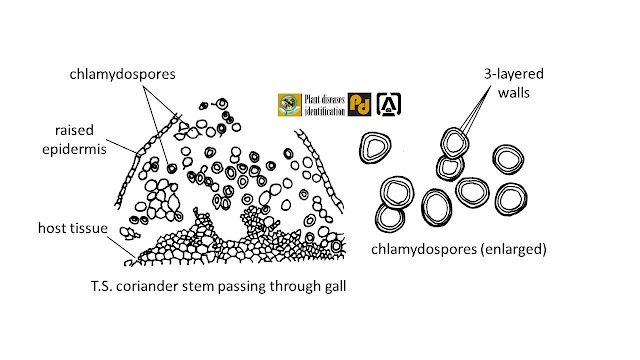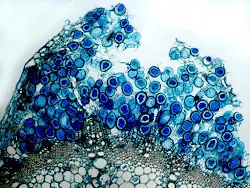Stem gall of coriander
Pathogen: Protomyces macrosporus
Host: Coriander (Coriandrum sativum L.)
Host: Coriander (Coriandrum sativum L.)
Geographical distribution
The disease has global
distribution. It is prevalent in all the areas of the world, wherever the coriander
is grown. The disease was first reported by Unger (1833) in Great Britain. In
India, Sydow and Butler (1911) first reported this disease from
Pusa (Bihar).
Symptoms

|

|
| Smooth elongated gall on younger stem of coriander | Rough galls on older parts of stem |
Symptoms of the disease appear as gall/tumor on the stems, peduncles and inflorescence. Galls are glossy and soft at the time of development, but become hard and rough in the older stems. Single gall is small (up to 1.0 cm in length), but more than two galls coalesce and become longer (up to 5 cm in length). The infected plants show deformation in the fruits and severe infection kills the whole plant. The disease causes heavy loss in the annual yield of coriander.
Causal organism
 |
| Protomyces diagram |
 |
| T.S of stem of coriander passing through gall showing chlamydospores |
Stem gall of coriander is caused by the fungus Protomyces macrosporus (Pavgi and Mukhopadhyay, 1972). The fungus is characterized by chlamydospores or endospores. These endospores are formed in the galls and are single-celled, yellowish-brown, spherical to globose. The chlamydospore has a very thick and protective outer unsculptured wall.
Disease cycle and epidemiology
The disease is seed-born. Primary inoculum of the disease is carried to the field with the seed drawn from an infected crop, crop debris and/or uncleaned seed mixed with fruit galls (Leharwan and Gupta, 2019). The hibernated thick-walled chlamydospores resist unfavorable dry environment and perenate summer, which may prolong for up to several years in absence of host. Chlamydospores germinate during the early winter in the host. The disease is favored by prolonged cold temperature (8-22 °C and 65 % relative humidity) of the winter season.
Control measures
- Stem gall of coriander is effectively suppressed by biological control. Treatment of seed, soil and foliar spray of Trichoderma viride and Pseudomonas fluorescens 40, 60 and 75 days of sowing reduce the disease up to 32 % (Leharwan and Gupta, 2019.
- Seed treatment and foliar spray of 1.0 % neem oil is effective in reducing the disease.
- Seed treatment with chemical fungicides, e.g, thiram, ceresan and omnamycin effectively reduces the disease.
References
- Pavgi, M.S. and Mukhopadhyay, A.N. (1972). Development of coriander fruit infected by Protomyces macrosporus Unger. Cytologia, 37:619-627.
- Leharwan, M. and Gupta, M., 2019. Stem Gall of Coriander: A Review. Agricultural Reviews, 40(2), pp.121-128.
- Sydow, H. and Butler, E.J. (1911). Fungi Indiae orientalis. Ann Mycol, 9:372- 421.
- Unger, F. (1833). Die. Exanthame der Pflanzen: 344 p.
Content first created on 12-11-2020
last updated on 05-12-2022
last updated on 05-12-2022





0 Comments
Leave your comments here.